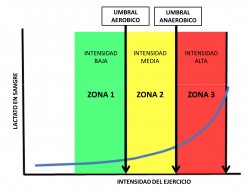Anaerobic Threshold: What is it and how to increase it for improvement?
Your heart rate and your physical fitness mark the fine line that defines your anaerobic threshold. When you are giving your all, you begin to locate where your anaerobic threshold is, and that's when you can measure and know it, to try to follow training patterns that allow you to increase it.
Along with glycogen control, they are the two most feasible and useful variables to control for the cyclist. Here, we explain how to do it.

But what is the anaerobic threshold?
The anaerobic threshold is like a glass ceiling: you don't see it, but it's there and it prevents you from performing more and better at maximum effort level. It's not your maximum, it's not your 100%, but that margin that marks when your body begins to act with an intensity that needs a lot of energy, so it starts to pull from your carbohydrate reserves anaerobically, that is, with a lack of oxygen for its decomposition.
RECOMENDADO

Tips for cycling in the rain

25 cycling gifts ideas to get it right

When do helmets have to be changed? Do they have an expiration date?

Some reasons to stay away from the road in winter

The best apps for cycling and mountain biking

Black Friday 2025 cycling bargains: save on Garmin, POC, Maxxis and more

And what does this mean? Well, in practice it's simpler: if you increase your anaerobic threshold you will be able to do sections with greater intensity in which you brush that anaerobic threshold but do not exceed it (having made it grow), and that will allow you to go more comfortable at higher power, and conserve carbohydrate consumption to have more resistance at high heart rates.
In other words, you will be able to put in more watts and more consistently without your body suffering as much from the demanding pace.

As advice, it is usually stated that to measure where your anaerobic threshold is, you should be able to implement a maximum pace on the bike that allows you to hold out for 30 minutes. If you withstand that time at that maximum pace you demand, you will have located your anaerobic threshold and, with graphs about your heart rate and power, you will be able to see quantitatively where it is and try to improve it.

How to shift your anaerobic threshold
Really, and it's already more than proven, the anaerobic threshold has a genetic component. This, although not totally determinant, is influential: there are cyclists who are genetically better equipped to reach a higher anaerobic threshold.
That said, with training almost everything is achievable, overcoming the predeterminations of origin, of birth.
Having said that, we also advise you that before trying to measure your anaerobic threshold you do some kilometers, 20 or 30 kilometers of warming up and physical acclimatization, with some small change of pace and above all having broken a sweat and having last stabilized your heart rate and cadence. Then, it will be time to see what level you are at.

Then, you can measure and improve your anaerobic threshold in several ways. In addition to doing it professionally, by measuring it in a scientific study where they monitor everything, we propose a couple of easier methods: first, with successions of 10 explosive minutes at 95% followed by another 10 of rest, at 60%, followed by a similar transition but of 20 explosive minutes followed by another 20 at medium effort. This is the best way to increase the anaerobic threshold, but not the only one.
You can also make the dynamics shorter: warm-up, location of the anaerobic threshold and then 5 minutes at 110%, followed by another 5 at the limit, at 100%. Continue with this succession for about 20 minutes, and your improvement will be noticeable.
There are several routines, but these two are the most useful and simple. You don't have to be measuring all the time, just time slots in which you will vary your intensity. There will be time at home to assess the data that comes from your training. That said, do these exercises a couple of times a week, and not successively. If you train to increase your anaerobic threshold on a Monday, do it again after Wednesday. Leave a couple of days interval before repeating these exercises, for proper recovery and rest.

Benefits of improving your anaerobic threshold
It's simple: the higher you place it, the better physical shape you will be in. Once you have located where your anaerobic threshold is, improving it is a matter of simple but well-defined training guidelines, like the ones we have pointed out.
If you follow any of these two simple guidelines, you will notice that, after two or three weeks, your anaerobic threshold has grown, and it may be 5 beats above when you started training it. That improvement in the anaerobic threshold is what will help you maintain a constant pace for a longer time. And the results as a consequence of this improvement, will undoubtedly surprise you.